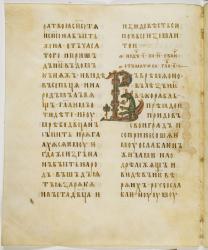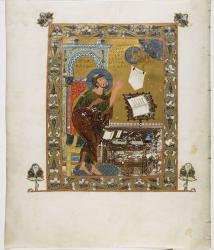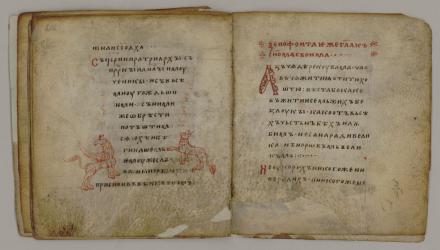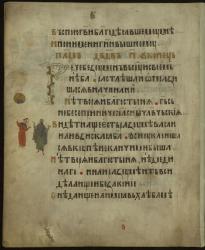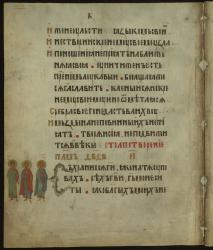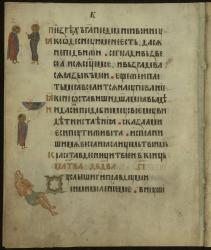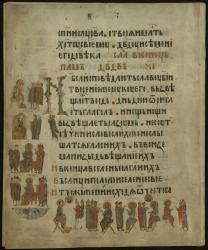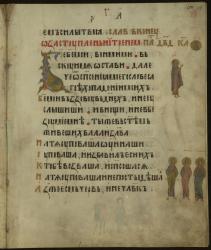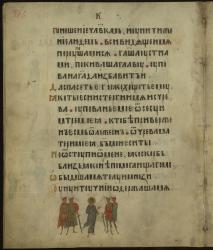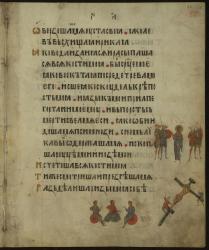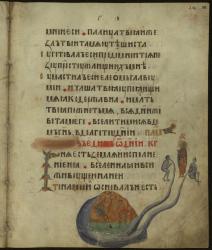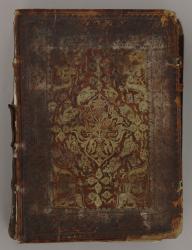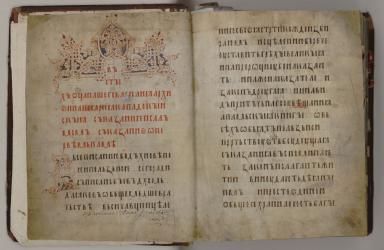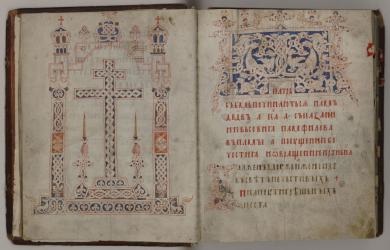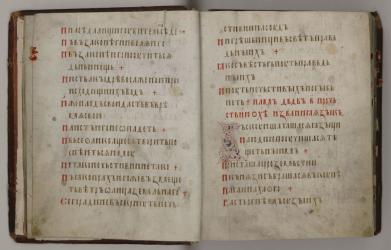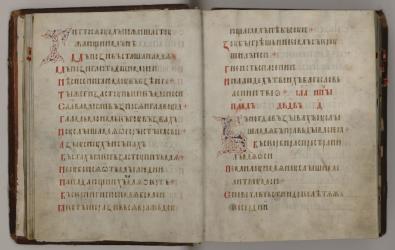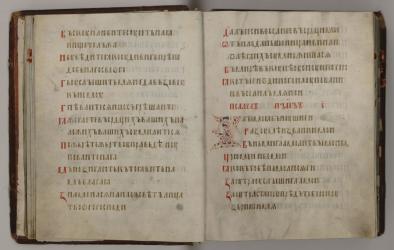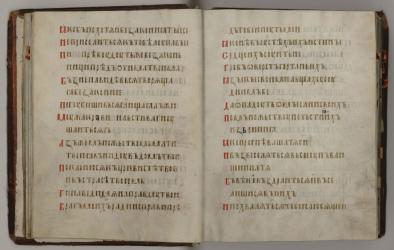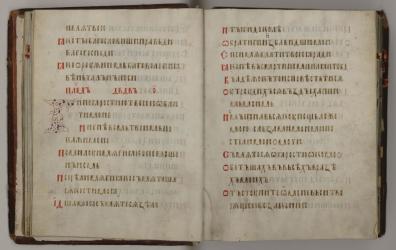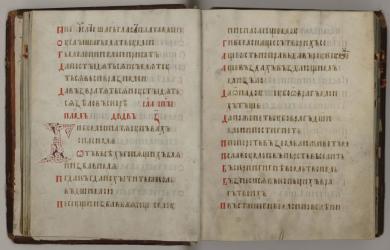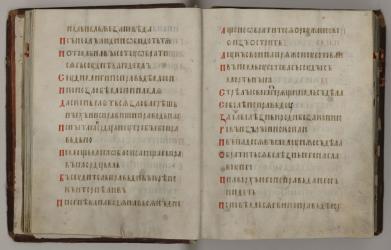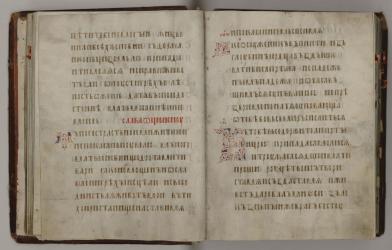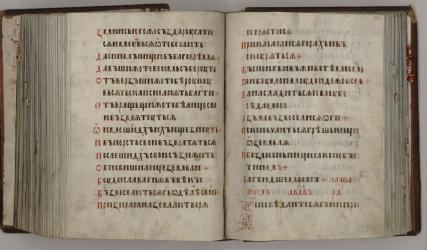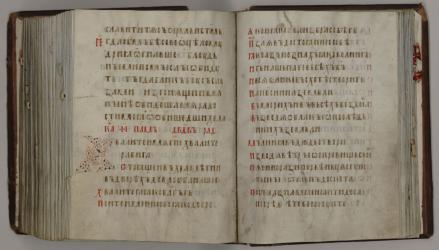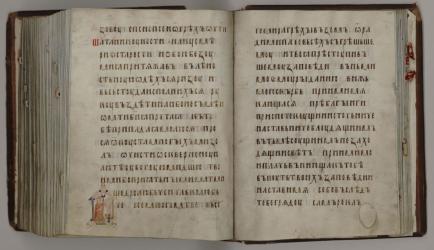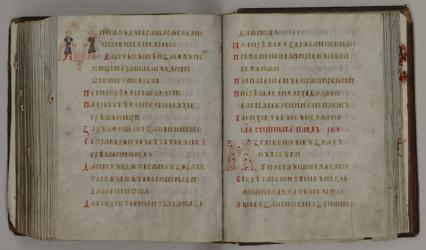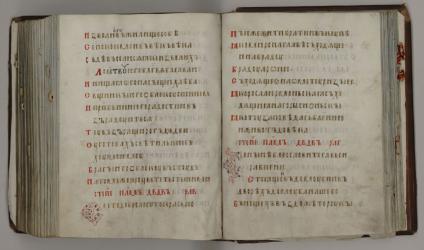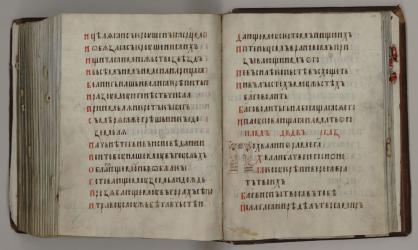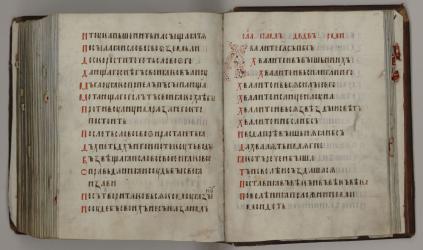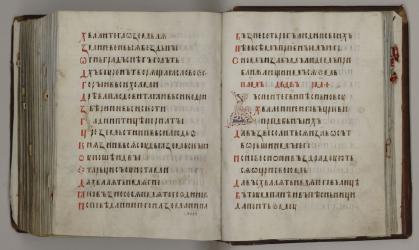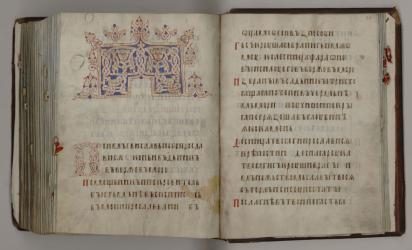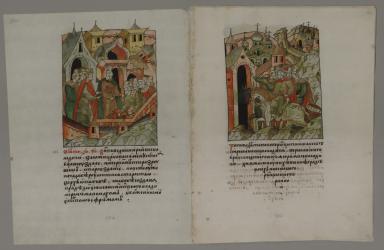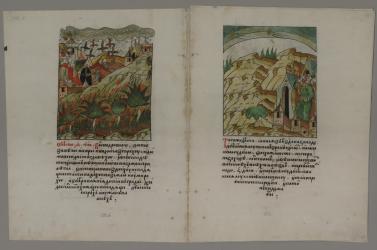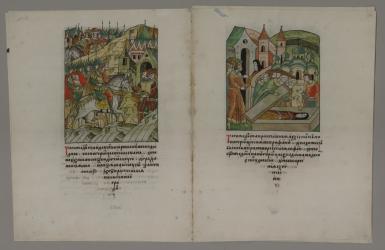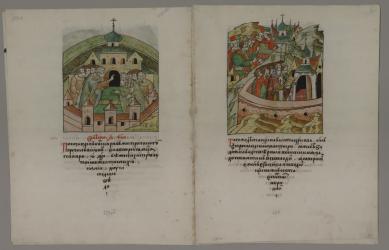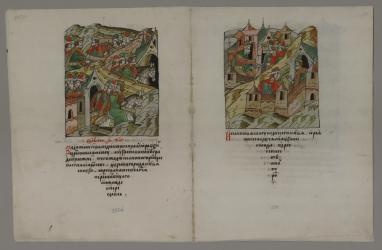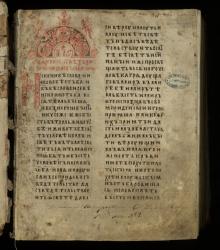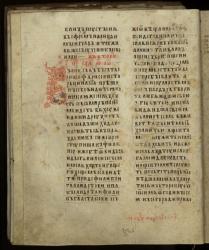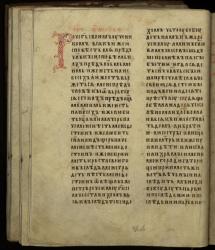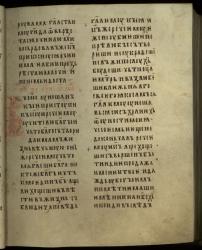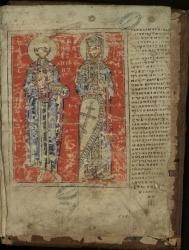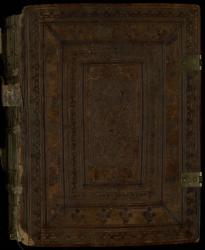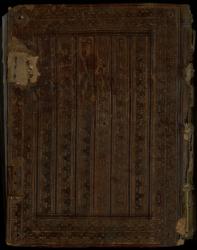Old Russian Manuscripts
With the establishment of Christianity as the state religion in the late tenth century, Russia adopted the Cyrillic script which had already been widely spread among the southern Slavs by that time.
The Library holdings comprehensively span the history of Russian manuscripts. The material dates from the 11th century Ostromir Gospel to the late Old Believers' manuscripts of the early twentieth century.The Old Russian manuscripts cover an extremely broad range of topics. Among them are not only richly decorated liturgical books and the most important historical chronicles but soul saving stories and books for practical use as herbalists, medical books, treatises on different fields of knowledge, including military affairs, and even textbooks on reading texts written in cursive. Of particular interest are miscellanies containing works of various genres: theological treatises, teaching discourses, lives of saints, novels, church polemical writings, Russian political essays and social commentary, syllabic verses.
To demonstrate the value of the Old Russian stocks, it is sufficient to mention that the National Library houses many earliest extant manuscripts. We might take as an example, the famous Ostromir Gospel of 1056–1057, the oldest dated Russian handwritten book to have come down to us today. The manuscript that saw the thousand-year path of Russian culture, was created during the epoch of flourishing of the Old Russian state for the Novgorod cathedral of St.Sophia — the main temple of north-western Russia. The Ostromir Gospel is included in UNESCO's Memory of the World list.
Apart from richly decorated books for use in church, like the Ostromir Gospel, the Manuscripts Department has a large number of more modestly decorated but no less valuable and interesting manuscripts intended as reading matter. Among them is the oldest dated Russian reading book, the Izbornik (Miscellany) of 1076. It comprises many stories with Christian morals for the lay people, above all, for the princely elite. The volume contains miscellaneous texts including the well-known Word on Respecting Books, Gennadius of Constantinople's One Hundred Chapters on Holy Faith, the Wisdom of Sirach, etc. The miscellany was compiled in Russia on the model of Izbornik of 1073, a copy from the Bulgarian original.Among the numerous handwritten copies of historical works is the oldest parchment copy of the Laurentian Chronicle of 1377. It is the earliest precisely dated Russian chronicle that has survived to our days. The volume includes the oldest extant version of Rus' Primary Chronicle telling the earliest history of East Slavic peoples The Laurentian Chronicle, the key source of all Russian historiography, is listed in UNESCO's Memory of the World register.
In 1932, the collection of the Society of Lovers of Ancient Literature added to the Old Russian stocks more than 3,000 Russian and Slavonic manuscripts, among them the celebrated Kiev Psalter of 1397, the earliest extant precisely dated illustrated Russian manuscript book. The manuscript contains more than 300 miniatures depicting or interpreting the text. Before the Kiev Psalter, the Old Russian manuscripts had only "facial" miniatures portraying the author of the text (evangelists, King David, etc.), members of the princely family, and the patron saints of the manuscript customer. The exquisite decorative elements such as fine illustrations, headpieces and initial letters make many of Old Russian manuscripts true works of art. For instance, the 14th century Florus Psalter, known to all art critics, is adorned with ornamental head-pieces and initials composed of animals. The Psalter is also remarkable for numerous figures of men introduced in initials' patterns.Unlike Western culture which developed in cities and universities, in Russia, the major book centers were monasteries. Manuscripts were created in monastery scriptoria, they were once part of the rich collections of monastic libraries. The National Lbrary now houses the collections of some of the oldest mediaeval Russian book repositories. The most notable is that of St Sophia's Cathedral in Novgorod, which included manuscripts produced in various book centers of north-eastern Russia. This collection contains unique copies of landmarks of Old Russian literature. Among them are the eleventh century Putiatin Menology, the twelfth-thirteenthth century Prologue, the author’s copy of the Life of St. Sergius of Radonezh written in the mid-fifteenth century by the famous hagiographer Pachomius the Serb as well as many other outstanding examples of Old Russian literature. Here too are the libraries dating back to the fifteenth century from the Kirillo-Belozersky and Solovetsky Monasteries. These collections have preserved the most valuable Russian medieval manuscripts, such as the fifteenth century encyclopedic miscellanies by the monk-scribe Euphrosynus, to our days.
The Manuscripts Department possesses the old Pantaleon Gospel with a rare miniature of St. Pantaleon and St. Catherine, the twelve volume The Great Menaion Reader by Metropolitan Macarius from the St. Sophia Monastery's collection. There are also four of the ten volumes of the tremendous Illuminated Compiled Chronicle created in the sixteenth century on the orders of Ivan the Terrible. Almost every page features colourful miniatures which provide highly valuable information on the landscape, culture and daily life of Old Russia and its neighbours.Old Russian books make not only educative, but also fascinating reading. Such, for example, is the Samara manuscript containing the Tale of Barlaam and Joasaph with entertaining plot lines and amazing ancient parables.
(изо-MA19088) The Old Russian holdings contain manuscripts of vocal music from the twelfth century onwards. The department has accumulated more than 1,000 vocal music codices, including a considerable collection of eighteenth- to twentieth-century Old Believers' manuscripts. These persecuted religious dissidents preserved for a long time the traditions of copying and decorating manuscript books. One of the five world-famous manuscripts distinguished by a special system of musical notation, the Annunciation Kontakia (Hymns) of the turn of the twelfth – thirteenth centuries, is kept here.
A separate group consists of both liturgical and secular music pieces of the seventeenth – nineteenth centuries, based on a five-line staff. They embrace panegyric chants and genres of spiritual lyrics. In these manuscripts, anonymous texts co-exist with the author's poetry of Symeon of Polotsk, Vasily Trediakovsky, Alexander Sumarokov, and Mikhail Lomonosov. This group also includes the most valuable book of Russian folklore poems, compiled by Kirsha Danilov. This collection is the first anthology of Russian epics and historical folksongs, with notes, to be published.
The Old Russian Sector also stores books and other handwritten material of the eighteenth – nineteenth centuries, which are not directly related to the Old Russian tradition. These are scientific, historical, literary manuscripts, works on military affairs, law, other branches of knowledge, personal diaries, maps, plans, travel albums, etc. The Hermitage collection contains manuscripts specially created for presentation to Russian emperors. Notable is the album Description of the Coin Manufacture by A. Nartov. The Hermitage collection also includes a valuable set of copies of Old Russian handwritten books and documents produced for Empress Catherine II in the eighteenth century.
Fragment from the Illustrated Chronicle of the Ivan the Terrible.
View the video film (in Russian).
See virtual exhibitions:
Panteleon Gospel
Old Russian Manuscript Gospels of the 12th - 17th Centuries.
Explore digitized manuscripts:
Life of St. Sergius of Radonezh by Pachomius the Serb
Euphrosynus Manuscripts - Fifteenth-century Miscellanies
of the "Leonardo da Vinci of Ancient Russia"
Samara Manuscript (in Russian)
Annunciation Kontakia (Hymns) (in Russian)
Russian Justice (in Russian)
Description of the Coin Manufacture by A. Nartov
Literary Old Russian Landmarks (in Russian).
